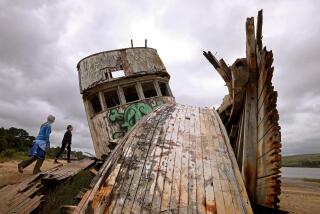Exxon Valdez Odyssey Ends in San Diego
SAN DIEGO — It was a smooth homecoming for the Exxon Valdez.
The odyssey of the beleaguered tanker ended early Sunday as the crippled vessel, escorted by a flotilla of tugs, Coast Guard vessels and environmentalists in sail and motorboats, crept into San Diego Bay and docked where it was first launched.
Nearly four months after it spilled 11 million gallons of crude oil along a pristine Alaskan shoreline, the worst oil spill in U.S. history, the Valdez completed a 3 1/2-hour transit through the bay as crowds lined piers to watch the infamous vessel’s arrival at a National Steel & Shipbuilding Co. dock.
“Everything went like clockwork. It was a piece of cake,” said Capt. Edward J. Silva Jr., the harbor pilot who guided the Valdez’s three-mile final leg to the 10 a.m. docking.
The tanker, towed nearly 60 miles from San Clemente Island, where jutting steel plates were removed from its hull, arrived just outside the bay late Saturday. An underwater survey showed no further hull damage, and Coast Guard Cmdr. Don Montoro gave clearance for the vessel’s entry into the bay.
Under clear skies, Silva slowly maneuvered the tanker, which had been drifting off San Diego since July 10 after being towed 2,200 miles from Alaska, past the resorts and shipyards that line the bay.
Coast Guard and Harbor Patrol boats formed a moving safety zone hundreds of yards around the ship in each direction, with vessels carrying pollution containment and salvage equipment not far behind.
Alongside the flotilla, eight Greenpeace boats carried environmentalists and signs demanding new energy policies and protesting the oil spill by the Valdez, which one Greenpeace leader called the “tragic symbol of fossil-fuel dependency.”
Shortly after tugboats helped turn the Valdez around and backed it up to the Nassco dock, a floating containment boom encircled the tanker to entrap any leaks, and a weary crew, some of whom had been on board since the ship ran aground in Alaska, stepped off.
No discharges such as those that came sporadically from the Valdez during the last three weeks were sighted during Sunday’s transit, Coast Guard Lt. Larry Solberg said.
The placid docking was in contrast to much of the history of the Exxon Valdez.
Two workers were killed while building the vessel at Nassco, where it was launched in 1986.
Spurned at San Diego
In the aftermath of the Alaska spill, the tanker arrived offshore San Diego 21 days ago for repairs, only to be turned away after steel plates were found peeled from its hull and an 18-mile oil slick was sighted nearby.
The jutting plates prevented the ship from clearing the bay’s bottom and had to be removed. And officials wanted to investigate whether the tanker, deemed “squeaky-clean” by Exxon officials before it left Alaska, was still leaking oil.
State officials demanded that Exxon meet stringent conditions before the vessel entered state waters and wrestled with the company about whether the ship had spilled crude off California.
For Exxon Shipping Co., the docking ended what company officials saw as an undeserved public relations nightmare.
“It’s taken four months to get here. We’ve done it safely and we’ve done it carefully,” said President Frank Iarossi, who added that the company may change the name of the vessel after its rebuilding.
Iarossi said the ship had carried no oil from Alaska, and denied state and Coast Guard findings that it was responsible for several spills off California, including the 18-mile slick.
“I’m denying the Valdez spewed oil (off San Diego). There was no oil on that ship,” he said.
For state officials the matter is far from resolved.
Test results received late Saturday confirmed earlier findings that the 18-mile slick was at least “95%” Alaskan North Slope crude oil, the cargo of the Valdez when it struck a reef in Alaska, officials said.
“I don’t have any doubt whatsoever” that the Valdez was the source of the slick, said Reed Smith, pollution response coordinator for the state Department of Fish and Game. “But it’s hard to deal with a ship owner who says they’ve never had a leak. It’s amazing they’re still denying it.”
Because the original slick and several other sheens believed to have come from the Valdez were found in federal waters, and because the vessel emitted no discharges as it passed through California waters, the state has no jurisdiction to file charges against Exxon, Smith conceded.
But the Coast Guard is awaiting test results from samples of waxy oil residue taken from inside the tanks of the Valdez, and those results and state evidence could fingerprint the tanker as the source of the spilled oil--and subject the company to federal civil or criminal penalties, he said.
Nassco workers will spend nine months and use 3,000 tons of steel to patch the tanker.
More to Read
Sign up for Essential California
The most important California stories and recommendations in your inbox every morning.
You may occasionally receive promotional content from the Los Angeles Times.









